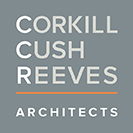Our Design Process
John F. Corkill, Jr started Corkill Associates Architects, now Corkill Cush Reeves. PA., in 1977. John had a desire to find a balance between quality architecture and successful business practices. We still believe project success is based on balancing a projects quality, quantity and cost.
Proper quality, quantity and cost controls are success factors which require care through steady communication and clarity by all parties. To frame these efforts CCR continues to be influenced by various Organic Architecture Principles. We’re informed by constraints such as site features and environmental needs. We also use both materials and forms honestly creating simplicity when possible to unify a functional and aesthetic vision.
Design informed by site and environment, found its inherent connections to sustainable architecture in our early work too. Our first passive and active sustainable projects were started in the 1970’s. Our sustainability efforts, now titled High Performance Design (HPD), have matured with a focus on simple-yet-elegant solutions. When opportunities exist we design-in simplicity and passivity instead of complex, active-sustainable systems.
Appropriate project-site orientation and qualities of the exterior shell remain passive keys to low cost, sustainable life-cycle operations. Another CCR strength is our in-house, design integration process. We’ve developed the capacity to engineer mechanical, electrical and plumbing systems in order to tailor their performance and spatial needs. We use several energy conservation & measurement systems including, but not limited to LEED.
After (40) years of leadership continuity these design principles are in our creative DNA. With John’s continued participation, Jim Cush and Bill Reeves have also helped develop and lead CCR for many years. Our decades of team building seem rare today. We’re all life-long learners both at work and through our continued international architecture studies. Humor & Humility are valuable resources here too. (visit Continuing Ed and Bio’s sections for more)
